Design of foundation for any structure is based on soil test report of construction site. Soil tests for construction of buildings or any structure is the first step in construction planning to understand the suitability of soil for proposed construction. Keeping this in mind our laboratory offers a variety of soil testing services for determining soil properties and behaviour to assess the subsoil strata.
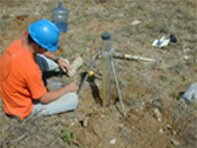
Natural Moisture Content
Determining the moisture content of soil using oven drying method as per IS 2720 – part 2. The natural water content also called the natural moisture content is the ratio of the weight of water to the weight of the solids in a given mass of soil. This ratio is usually expressed as percentage. In almost all soil tests, natural moisture content of the soil is to be determined.

Grain Size Analysis
Determining the particle size analysis using standard Sieves as per IS 2720- part 4. The particle size distribution is mainly used for soil classification.

Specific Gravity
Determining the specific gravity of soil samples using density bottle as per IS 2720 – part 3/sec 2. Specific gravity is the ratio of the weight in air or a given volume of a material at a standard temperature (normally 27ºC) to the weight in air of an equal volume of distilled water. The knowledge of specific gravity is needed in calculation of soil properties like void ratio, degree of saturation etc
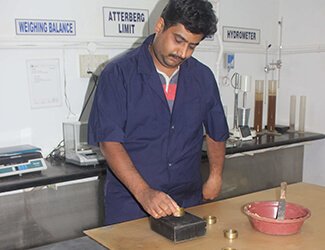
Atterberg Limits
Determining the consistency of soils like liquid limit, plastic limit and shrinkage factors as per IS 2720 parts 5&6. The behaviour of all the soils and especially “clays” considerably differs in the presence of water. The Atterberg limits are a basic measure of the consistency of a fine grained soil which is related to a large extent to the water content, such as liquid limit, plastic limit and shrinkage limit
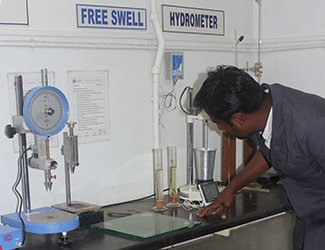
Free Swell Index
Determining the free swell index of cohesive or expansive soils as per IS 2720- part 40. The clay and especially black cotton soils have a tendency to swell in small or more proportion when submerged in water. Free swell or differential free swell also termed as free swell index, is the increase in volume of soil without any external constraint when subjected to submergence in water.
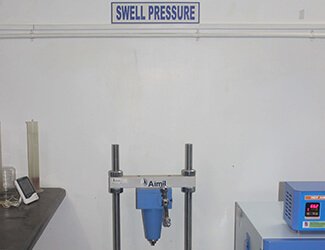
Swell Pressure
Determining the swelling pressure of cohesive or expansive soils as per IS 2720-part 41. The one-dimensional consolidometer test has been defined as the pressure which prevents the specimen from swelling or the pressure which is required to return a swelled specimen to its original state (void ratio, height) prior to swelling.

Relative Density
Determining the relative density of cohesionless soils as per IS 2720 – part. Relative density or density index is the ratio of the difference between the void ratios of cohesion less soil in its loosest state and existing natural state to the difference between its void ratio in the loosest and densest states.
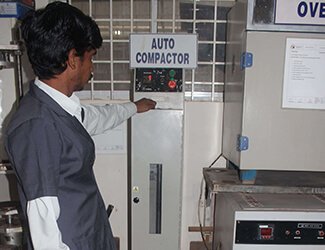
Compaction Test
Determining the maximum dry density (MDD) and optimum water content (OMC) of soil as per IS 2720 – parts 7&8. Soil compaction is defined as the method of mechanically increasing the density of soil. In construction this is a significant part of the building process. If performed improperly the settlement of soil could occur and result in unnecessary maintenance costs or structure failure. Almost all types of building sites and construction projects utilize mechanical compaction techniques.

California Bearing Ratio (CBR)
Determining California Bearing Ratio of soils for pavement/foundation designs as per IS 2720 – part 16. The CBR test is a penetration test meant for the evaluation of subgrade strength of road and pavements. The results obtained by these tests are used with the empirical curves to determine the thickness of pavement and its component layers. This is the most widely used method for the design of flexible pavement.

Direct Shear Test
Determining shear strength parameters of soil as per IS 2720- part 13. This test is mostly recommended for granular soils and also for soils containing some cohesive soil content. The cohesive soils have issues regarding controlling the strain rates to drained, or undrained loading. In granular soils, the loading can be always assumed to be drained.
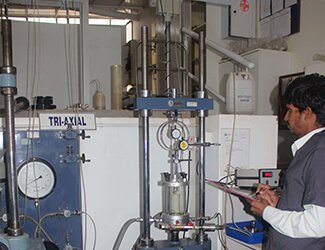
Tri-axial Shear Test
Determining shear strength parameters of cohesive soil as per IS 2720- part 11&12. In this test stress is applied to the sample in a way which results in stresses along one axis being different from the stresses in perpendicular directions. This is typically achieved by placing the sample between two parallel platens which apply stress in one direction, and applying fluid pressure to the specimen to apply stress in the perpendicular directions. This test is mostly suitable for cohesive soils or for soils having a larger percentage of cohesive content.

Consolidation Test
Determining consolidation parameters of soil as per IS 2720 – part 15. This test is performed to determine the magnitude and rate of volume decrease that a laterally confined soil specimen undergoes when subjected to different vertical pressures. From the measured data, the consolidation curve can be plotted. This data is useful in determining the coefficient of consolidation and coefficient of secondary compression of the soil.

Permeability Test
Determining permeability of soils as per IS 2720-part 17. The soil permeability is a measure indicating the capacity of a soil to allow fluids to pass through it. The permeability coefficient is determined in the laboratory using falling head or constant head depending upon the type of soil. The knowledge of this property is much useful in solving problems involving yield of water bearing strata , seepage through earthen dams, stability of earthen dams and embankments of canal bank affected by seepage, settlement etc.

Unconfined Compression Test on Rock
Determining Unconfined compressive strength of rock core samples as per IS 9143. This test is used to determine the strength of rock sample when crushed in one direction in tri-axial test without any lateral restraint.

Point Load Index
Determining point load index (PLI) of rock core samples as per IS 8764. This test is an outgrowth of experiments with compression of irregular pieces of rock in which it was found that the shape and size effects were relatively small and could be accounted for, and in which the failure was usually by induced tension.

Chemical Analysis of Soil and Water
Analysing water and soil samples for pH, Sulphates, Chlorides & Organic Matter. From an engineering point of view, determination of the pH of the soil mass is essential. For construction works, highly acidic soil will affect the bitumen stability of roads and have adverse effects on concrete strength. Presence of sulphates in soil can also be detrimental to structures built on such soils.

